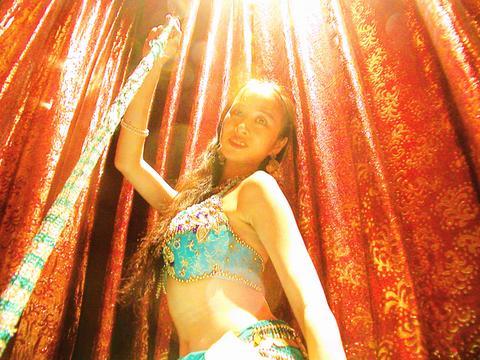When a local belly dancer with a BA in diplomacy is keen to discuss the Middle-East situation at your favorite lounge, it is hard to say no.
Gary Chen (

PHOTO: JULES QUARTLY, TAIPEI TIMES
It is an eerily suitable venue, with a large hookah standing proud on each table. The tinseled curtains and the draped areas of the private booths add to the Arabic delight of it all. Glasses clink and aromatic tobaccos, cooled by the deep-bowled pipe, drift toward the ducts.
Violet has been dancing since she was a four-year-old in Yunlin, a farming area between Chunghua and Chiayi, and was performing traditional Chinese dances called tsai dai (彩帶) when she was seven. But she got into belly dancing after doing research in Israel as part of her degree in diplomacy at National Chengchi University. She joined the Arabesque Dance Troupe there, partly because she wanted to dance, but also because it was a political statement: the group is, unusually, part Jewish, part Palestinian.
"There has been fighting in that region for thousands of years. Fifty years ago I would not have agreed with the plan of a Jewish state but it is there now and that is it, so we must search for the peace ? But it is not for the minority to govern the majority," Violet said.
As well as doing political punditry, dancing and running promotions for CTTV, she has also started her own belly-dancing school and aims to be teaching upward of 200 students a week by the end of the year.
"Really, it is not belly dancing. This was a word invented by Westerners when they saw women dancing with their bellies [exposed]. The real word is Raks Sharki and this means `oriental dancing.'"
Not shy about the suggestiveness of the dance, however, Violet said the mystery and writhing was part of the allure.
"It's a very good dance, especially for women, who use all their body. Yes, I want to be sexy. It's an opportunity for us to show off how sexy we are."
She said belly dancing helped older women overcome fears of their feminity and kept youngsters trim. Also, it is not a bad business, since it is well-placed to become popular in Taiwan now that it has gone mainstream as an exercise and confidence builder in California.
There are other Chinese belly dancers, mainly Muslims in Xinjiang (
Tip: For the full flavor, collect friends, order a private booth, dine on imported French snails (NT$160), smoked salmon caesar salad (NT$220), whatever, a bottle of something nice and ask for a hookah. The staff will light a bowl for you containing low-nicotine tobacco, honey, and one of five flowers (apple, cherry, mango, jasmine and rose). Relax, each individual has his or her own pipe end to pull from and up to eight people can indulge at the same time. Chen's friends insist on going through all five flavored tobaccos. DJ @llan plays around 3am. The booth is NT$3,000, and you get the same amount's worth of food and drink.
Violet performs every Friday, after midnight. Woodstock, 218, Chinshan South Road, Sec 2, Taipei (台北市金山南路二段218號). Call (02) 2322 4677.

On April 26, The Lancet published a letter from two doctors at Taichung-based China Medical University Hospital (CMUH) warning that “Taiwan’s Health Care System is on the Brink of Collapse.” The authors said that “Years of policy inaction and mismanagement of resources have led to the National Health Insurance system operating under unsustainable conditions.” The pushback was immediate. Errors in the paper were quickly identified and publicized, to discredit the authors (the hospital apologized). CNA reported that CMUH said the letter described Taiwan in 2021 as having 62 nurses per 10,000 people, when the correct number was 78 nurses per 10,000

As we live longer, our risk of cognitive impairment is increasing. How can we delay the onset of symptoms? Do we have to give up every indulgence or can small changes make a difference? We asked neurologists for tips on how to keep our brains healthy for life. TAKE CARE OF YOUR HEALTH “All of the sensible things that apply to bodily health apply to brain health,” says Suzanne O’Sullivan, a consultant in neurology at the National Hospital for Neurology and Neurosurgery in London, and the author of The Age of Diagnosis. “When you’re 20, you can get away with absolute

May 5 to May 11 What started out as friction between Taiwanese students at Taichung First High School and a Japanese head cook escalated dramatically over the first two weeks of May 1927. It began on April 30 when the cook’s wife knew that lotus starch used in that night’s dinner had rat feces in it, but failed to inform staff until the meal was already prepared. The students believed that her silence was intentional, and filed a complaint. The school’s Japanese administrators sided with the cook’s family, dismissing the students as troublemakers and clamping down on their freedoms — with

As Donald Trump’s executive order in March led to the shuttering of Voice of America (VOA) — the global broadcaster whose roots date back to the fight against Nazi propaganda — he quickly attracted support from figures not used to aligning themselves with any US administration. Trump had ordered the US Agency for Global Media, the federal agency that funds VOA and other groups promoting independent journalism overseas, to be “eliminated to the maximum extent consistent with applicable law.” The decision suddenly halted programming in 49 languages to more than 425 million people. In Moscow, Margarita Simonyan, the hardline editor-in-chief of the